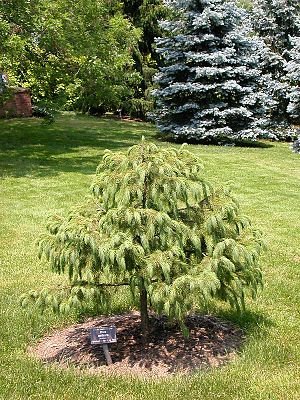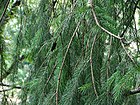Note: This is a project under development. The articles on this wiki are just being initiated and broadly incomplete. You can Help creating new pages.
Difference between revisions of "Picea smithiana"
| Line 1: | Line 1: | ||
| − | + | [[File:Picea smithiana.jpg|thumb|right]] | |
| + | '''Picea smithiana''' is an evergreen tree that can grow up to 30 metres tall. An important timber tree that can yield excellent construction material of large size, it is much harvested from the wild for commercial use. The tree also has a range of traditional uses as a food and source of materials. It is grown as an ornamental, where its long needles, drooping branches and bright green seed cones make it an ornamental tree of considerable merit. | ||
==Uses== | ==Uses== | ||
{{Uses|}}, {{Uses|}}, {{Uses|}}, {{Uses|}}, {{Uses|}}, {{Uses|}}, {{Uses|}}, {{Uses|}}, {{Uses|}}, {{Uses|}}, {{Uses|}}.<ref name="Uses"/> | {{Uses|}}, {{Uses|}}, {{Uses|}}, {{Uses|}}, {{Uses|}}, {{Uses|}}, {{Uses|}}, {{Uses|}}, {{Uses|}}, {{Uses|}}, {{Uses|}}.<ref name="Uses"/> | ||
==Parts Used== | ==Parts Used== | ||
| − | {{Parts Used|}}, {{Parts Used| | + | {{Parts Used|Seeds}}, {{Parts Used|Inner bark}}. |
==Chemical Composition== | ==Chemical Composition== | ||
| − | <ref name="chemical composition"/> | + | It contains the major compounds of oil were delta-3-carene (26.0%), limonene (25.0%), βpinene (14.0%), and ά-pinene (6.6%). Therefore delta-3-carene (26.0%) and limonene |
| + | (25.0%) determined the chemotype of the Kashmir P. smithiana oil etc.<ref name="chemical composition"/> | ||
==Common names== | ==Common names== | ||
| Line 16: | Line 18: | ||
===Dravya=== | ===Dravya=== | ||
===Rasa=== | ===Rasa=== | ||
| − | |||
===Guna=== | ===Guna=== | ||
| Line 29: | Line 30: | ||
==Habit== | ==Habit== | ||
| − | {{Habit|}} | + | {{Habit|Evergreen tree}} |
==Identification== | ==Identification== | ||
| Line 48: | Line 49: | ||
==Mode of Propagation== | ==Mode of Propagation== | ||
| − | {{Propagation|}} | + | {{Propagation|Seeds}}, {{Propagation|Cuttings of semi-ripe terminal shoots}}, {{Propagation|Cuttings of mature terminal shoots}}, {{Propagation|Cuttings of soft to semi-ripe wood}}. |
==How to plant/cultivate== | ==How to plant/cultivate== | ||
| − | <ref name="How to plant/cultivate"/> | + | The climate is moist monsoon, with abundant precipitation in two rainy seasons, but becoming gradually drier in the western parts of the range. Some of the precipitation falls as snow which accumulates over winter.<ref name="How to plant/cultivate"/> |
==Commonly seen growing in areas== | ==Commonly seen growing in areas== | ||
| Line 58: | Line 59: | ||
==Photo Gallery== | ==Photo Gallery== | ||
<gallery class="left" caption="" widths="140px" heights="140px"> | <gallery class="left" caption="" widths="140px" heights="140px"> | ||
| − | + | File:Picea smithiana 002.jpg | |
| + | File:Picea smithiana Brno4.JPG | ||
| + | File:Picea smithiana, RBGE 2008.jpg | ||
</gallery> | </gallery> | ||
| Line 64: | Line 67: | ||
<references> | <references> | ||
| − | <ref name="chemical composition">[ | + | <ref name="chemical composition">[https://shodhganga.inflibnet.ac.in/bitstream/10603/191929/14/14_chapter%20%204.pdf Chemical constituents]</ref> |
| − | <ref name="Leaf">[ | + | <ref name="Leaf">[Morphology]</ref> |
| − | <ref name="How to plant/cultivate">[ | + | <ref name="How to plant/cultivate">[http://temperate.theferns.info/plant/Picea+smithiana Cultivation]</ref> |
<ref name="Uses">Indian Medicinal Plants by C.P.Khare</ref> | <ref name="Uses">Indian Medicinal Plants by C.P.Khare</ref> | ||
</references> | </references> | ||
==External Links== | ==External Links== | ||
| − | * [ ] | + | * [https://plants.ces.ncsu.edu/plants/picea-smithiana/ Picea smithiana on plants.edu] |
| − | * [ ] | + | * [https://conifersociety.org/conifers/picea-smithiana/ Picea smithiana on conifersociety.org] |
| − | * [ ] | + | * [http://www.missouribotanicalgarden.org/PlantFinder/PlantFinderDetails.aspx?taxonid=285035 Picea smithiana on missouribotanicalgarden.org] |
[[Category:Herbs]] | [[Category:Herbs]] | ||
[[Category:Pages without herbs images]] | [[Category:Pages without herbs images]] | ||
Latest revision as of 10:35, 2 July 2020
Picea smithiana is an evergreen tree that can grow up to 30 metres tall. An important timber tree that can yield excellent construction material of large size, it is much harvested from the wild for commercial use. The tree also has a range of traditional uses as a food and source of materials. It is grown as an ornamental, where its long needles, drooping branches and bright green seed cones make it an ornamental tree of considerable merit.
Contents
- 1 Uses
- 2 Parts Used
- 3 Chemical Composition
- 4 Common names
- 5 Properties
- 6 Habit
- 7 Identification
- 8 List of Ayurvedic medicine in which the herb is used
- 9 Where to get the saplings
- 10 Mode of Propagation
- 11 How to plant/cultivate
- 12 Commonly seen growing in areas
- 13 Photo Gallery
- 14 References
- 15 External Links
Uses
[[:Category:Ayurvedic Herbs known to be helpful to treat |]], [[:Category:Ayurvedic Herbs known to be helpful to treat |]], [[:Category:Ayurvedic Herbs known to be helpful to treat |]], [[:Category:Ayurvedic Herbs known to be helpful to treat |]], [[:Category:Ayurvedic Herbs known to be helpful to treat |]], [[:Category:Ayurvedic Herbs known to be helpful to treat |]], [[:Category:Ayurvedic Herbs known to be helpful to treat |]], [[:Category:Ayurvedic Herbs known to be helpful to treat |]], [[:Category:Ayurvedic Herbs known to be helpful to treat |]], [[:Category:Ayurvedic Herbs known to be helpful to treat |]], [[:Category:Ayurvedic Herbs known to be helpful to treat |]].[1]
Parts Used
Chemical Composition
It contains the major compounds of oil were delta-3-carene (26.0%), limonene (25.0%), βpinene (14.0%), and ά-pinene (6.6%). Therefore delta-3-carene (26.0%) and limonene (25.0%) determined the chemotype of the Kashmir P. smithiana oil etc.[2]
Common names
| Language | Common name |
|---|---|
| Kannada | |
| Hindi | |
| Malayalam | |
| Tamil | |
| Telugu | |
| Marathi | |
| Gujarathi | |
| Punjabi | |
| Kashmiri | |
| Sanskrit | |
| English |
Properties
Reference: Dravya - Substance, Rasa - Taste, Guna - Qualities, Veerya - Potency, Vipaka - Post-digesion effect, Karma - Pharmacological activity, Prabhava - Therepeutics.
Dravya
Rasa
Guna
Veerya
Vipaka
Karma
Prabhava
Habit
Identification
Leaf
| Kind | Shape | Feature |
|---|---|---|
Flower
| Type | Size | Color and composition | Stamen | More information |
|---|---|---|---|---|
| {{{5}}} |
Fruit
| Type | Size | Mass | Appearance | Seeds | More information |
|---|---|---|---|---|---|
Other features
List of Ayurvedic medicine in which the herb is used
Where to get the saplings
Mode of Propagation
Seeds, Cuttings of semi-ripe terminal shoots, Cuttings of mature terminal shoots, Cuttings of soft to semi-ripe wood.
How to plant/cultivate
The climate is moist monsoon, with abundant precipitation in two rainy seasons, but becoming gradually drier in the western parts of the range. Some of the precipitation falls as snow which accumulates over winter.[4]
Commonly seen growing in areas
[[:Category:Herbs that are commonly seen in the region of |]], [[:Category:Herbs that are commonly seen in the region of |]], [[:Category:Herbs that are commonly seen in the region of |]], [[:Category:Herbs that are commonly seen in the region of |]], [[:Category:Herbs that are commonly seen in the region of |]].
Photo Gallery
References
- ↑ Indian Medicinal Plants by C.P.Khare
- ↑ Chemical constituents
- ↑ [Morphology]
- ↑ Cultivation
External Links
- Ayurvedic Herbs known to be helpful to treat
- Herbs with Seeds used in medicine
- Herbs with Inner bark used in medicine
- Habit - Evergreen tree
- Index of Plants which can be propagated by Seeds
- Index of Plants which can be propagated by Cuttings of semi-ripe terminal shoots
- Index of Plants which can be propagated by Cuttings of mature terminal shoots
- Index of Plants which can be propagated by Cuttings of soft to semi-ripe wood
- Herbs that are commonly seen in the region of
- Herbs
- Pages without herbs images



